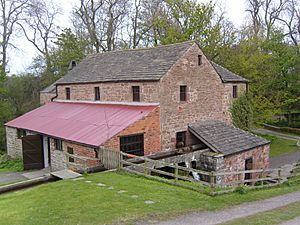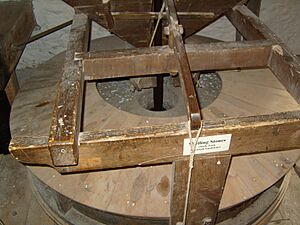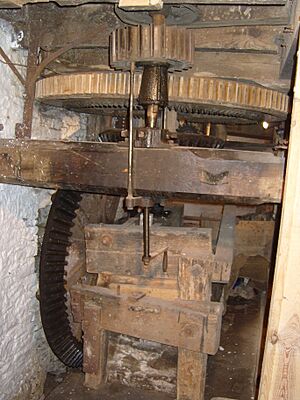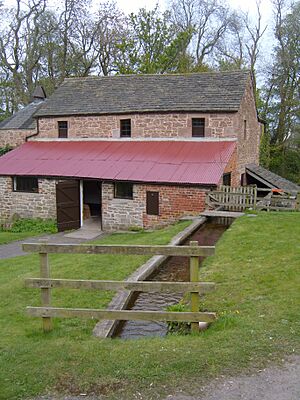Barry Mill facts for kids
Barry Mill is an amazing old watermill in Barry, Angus, in eastern Scotland. It's a special place, listed as a Category A building, which means it's very important! The National Trust for Scotland looks after it. They run it as a fun place for visitors to learn.
The mill sits in a quiet spot next to the Barry Burn. This is a small river that gives the mill its power. Barry Mill is about half a mile north of Barry village, close to the town of Carnoustie. It has three floors: a basement (called the meal floor), a milling floor, and a top floor (called the bin floor). People have used this site for mills since at least 1539. Barry Mill worked as a business until 1984. After that, it was fixed up and has been open to visitors since 1992. In 2009, it was almost closed, but people in the local area helped keep it open.
Contents
How Barry Mill Works
When Barry Mill is working, it turns oats into oatmeal. Oatmeal used to be a very common food in Scotland. In the past, farmers brought sacks of oats to the mill. These oats had already been threshed. Threshing is when you separate the grain from the plant. You can see an old threshing machine at the mill.
The oats were then dried in the mill's special oven, called a kiln. This kiln used peat for fuel. After drying, the oats slid down a chute to the basement. There, they were put into sacks again. Today, the oats arrive already dried. But the rest of the milling process is still done the old way.
From Oats to Oatmeal
First, the oats are lifted to the top floor, called the bin floor. From there, they drop into a large funnel called a hopper. This hopper feeds the oats into one of the mill's two pairs of millstones. These first millstones are made of sandstone. They shell the grain, which means they take off the outer husks.
The shelled oats, called "groats," then go down a chute to the basement. A fan separates the groats from the husks. The groats are then lifted back to the top floor. They go through the second pair of millstones. These stones are made of a special French stone. This second grinding turns the groats into oatmeal. Finally, the oatmeal goes down to the basement to be put into bags.
Powering the Mill
The Barry Burn provides all the power for the mill. There is a working dam and a channel, called a lade, about half a mile upstream. This lade guides water to the mill wheel. The mill wheel is very big, about 15 feet 6 inches (4.7 meters) across. Water from the lade drops onto the top of the wheel. This type of wheel is called an overshot waterwheel.
Inside the mill's basement, a system of levers, cogs, and gears controls the power. These parts make the millstones turn. They also power the hoists that lift the oats. And they run the fan that separates the groats from the husks.
History of Barry Mill
We know there was a mill here as early as 1539. Back then, there were actually two mills on the Barry Burn. Both were owned by a place called Balmerino Abbey in Fife. One was a corn mill, called "the Nether Mill." The other was an oat mill, called "the Over Mill."
In 1587, the King took over the abbey's lands. Later, in 1605, these lands were given to James Elphinstone, 1st Lord Balmerino. In the late 1600s, the mills were sold to Robert Watson. His son-in-law, Robert Gardyne, took them over in the 1680s.
The Nether Mill stopped working as a mill. The building, which was built in 1783, is now used for storage. In 1814, the Over Mill, which became known simply as "Barry Mill," was destroyed by a fire. The mill you see today was rebuilt by its owner, Thomas Gardyne.
The Gunn family bought the mill in 1926. It was made even bigger in the 1930s. Barry Mill kept making oatmeal until the late 1970s. After that, it only made food for animals. In 1984, floods damaged the lade, and the mill stopped working as a business.
Saving the Mill
The National Trust for Scotland bought the mill in 1988. It was in bad shape, but they spent four years fixing it up. They made it look just like it did in 1814. Barry Mill reopened in 1992. Now, it runs to show people how mills used to work. You can often see demonstrations on weekends. The old stables have been turned into a visitor center. The mill also has displays about the lives of millers.
In 1971, Historic Scotland gave the mill and a nearby bridge special status as Category B listed buildings. The old Nether Mill building got a Category C listing in 1980. Barry Mill was upgraded to a Category A listing in December 2009. This means it's a very important historical building.
Keeping Barry Mill Open
In 2009, Barry Mill was not getting many visitors, only about 2,000 a year. The National Trust for Scotland was having money problems. They said Barry Mill might have to close. But local people quickly formed a group called "Friends of Barry Mill." They worked hard to raise money and save the mill.
In July 2009, the Trust announced good news! Barry Mill would stay open. This was possible because Angus Council and the Gibson Graham Charitable Trust promised to help with money. Thanks to this support, Barry Mill is still open today for everyone to enjoy and learn from.






